Onboarding
With the moov-onboarding element, users can enter individual or business information to create an account, and Moov handles the verification process. The onboarding Drop takes care of the entire account creation workflow, with UX features to keep the information collection process as seamless as possible.

Visit our Drops 101 guide to learn the basics of properties, attributes, and initializing Drops.
Properties
Properties can be accessed through JavaScript using a reference to the moov-onboarding element.
| Property | Type | Description |
|---|---|---|
token |
String | Auth Token used for hitting the API. See the Scopes section for more detail. |
facilitatorAccountID |
String | ID for the facilitator account. The account created through onboarding will be connected to this account. |
accountData |
Object | Partial account data used to pre-populate fields in the onboarding dialog. |
capabilities |
String[] | The capabilities requested by this account. Fields in the onboarding dialog will be marked as optional or required based on the requested capabilities. |
open |
Boolean | Whether or not the dialog is currently displayed to the user. |
onResourceCreated |
Function | Callback fired when the onboarding dialog creates a new resource (account, payment method, etc). Use this callback to update your token with the appropriate scopes before creating the next resource. See the Scopes section for more detail. |
onError |
Function | Callback fired when the onboarding dialog encounters an error. |
onCancel |
Function | Callback fired when the user attempts to close the dialog. |
onSuccess |
Function | Callback fired when the user completes the onboarding process. |
plaid |
Object | A Plaid configuration object. Used for setting up a payment method through Plaid. |
onPlaidRedirect |
Function | Callback fired after following a redirect from Plaid. Provides a restoredProperties object which can be used to restore the state of the drop. |
paymentMethodTypes |
String[] | An array of allowed payment method types. Possible values are card or bankAccount. |
allowedCardBrands |
String[] | An array of allowed card brands. If this field is not provided, all card brands will be accepted. Accepted values are visa, mastercard, american-express, diners-club, discover, jcb, unionpay, maestro, mir, elo, hiper, or hipercard. |
microDeposits |
Boolean | If false, hides the micro deposit verification step when adding a payment method. Defaults to true. |
How to set a property
|
|
|
|
|
|
Attributes
String-type properties can be set via attributes on the HTML <moov-onboarding> element.
| Attribute | Description |
|---|---|
token |
Auth Token used for hitting the API. See the Scopes section for more detail. |
facilitator-account-id |
ID for the facilitator account. The account created through onboarding will be connected to this account. |
Scopes
The moov-onboarding Drop requires different scopes at different steps in the onboarding process.
As users move through the onboarding flow, the Drop creates new resources (accounts, payment methods, etc), and it needs the appropriate permissions to read or modify those resources. The developer is responsible for updating the onboarding token with new scopes as resources are created.
- Create a token with the following initial scopes:
accounts.writeaccounts/{facilitatorAccountID}/profile.readfed.readprofile-enrichment.read
- Initialize the onboarding Drop with the token.
1 2// Get `myToken` with initial scopes onboarding.token = myToken; - The user enters information for their new account.
- The onboarding Drop creates the account and fires the
onResourceCreatedcallback.1 2 3 4onboarding.onResourceCreated = ({ resourceType, resource }) => { // This fires when the account is created console.log("Resource created! ", resource); } - Get the account from the
onResourceCreatedcallback:1 2 3 4 5onboarding.onResourceCreated = ({ resourceType, resource }) => { if (resourceType === "account") { // Save the account resource somewhere } }; - Use the account ID to create a new token and add the following scopes:
- All initial scopes
/accounts/{newAccountID}/bank-accounts.read/accounts/{newAccountID}/bank-accounts.write/accounts/{newAccountID}/capabilities.read/accounts/{newAccountID}/capabilities.write/accounts/{newAccountID}/cards.read/accounts/{newAccountID}/cards.write/accounts/{newAccountID}/profile.read/accounts/{newAccountID}/profile.write/accounts/{newAccountID}/representatives.read/accounts/{newAccountID}/representatives.write
- Update the onboarding Drop with the new token:
1 2// Get `myToken2` with account-related scopes onboarding.token = myToken2; - The user can now continue on to add payment methods to the account.
Theming
Visit our guide on themes to learn how to re-style Moov Drops.